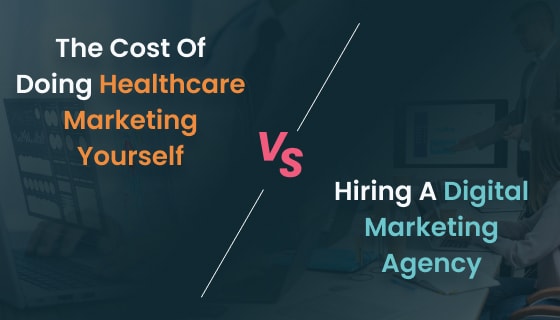Introduction
In the dynamic landscape of healthcare marketing, businesses deploy multifaceted digital strategies. To gauge their effectiveness, understanding the impact of endeavors like AD campaigns, content creation, social media, and SEO is crucial.
Enter conversion tracking – the linchpin in evaluating the success of these initiatives. Patient conversion metrics unveil the efficacy of marketing campaigns, offering profound insights into patient behavior.
In the realm of healthcare, the definition of ‘conversion’ varies, aligning with specific campaign objectives. Unraveling patient preferences and buying patterns, conversion tracking empowers businesses with actionable data.
For a comprehensive approach, integrating Google Analytics and Google Ads conversion tracking is imperative. This article unfolds the significance of conversion tracking in healthcare, delving into setup intricacies for both Google Analytics and Google Ads. Elevate your healthcare marketing game – embrace conversion tracking and transform insights into actionable strategies for unparalleled success.
Why Is Conversion Tracking Important?
In the intricate landscape of healthcare marketing, understanding the significance of conversion tracking is paramount. It serves as the compass guiding businesses through the digital realm, providing clarity on the effectiveness of various strategies.
Conversion tracking, tailored to healthcare, enables precise measurement of campaign success, offering insights into patient behavior, preferences, and the overall impact of marketing efforts.
By decoding conversion metrics, healthcare professionals can refine their approach, ensuring every marketing initiative aligns with patient-centric goals and achieves optimal outcomes.
![]()
Incredible Benefits Of Conversion Tracking
Embracing conversion tracking in healthcare unveils a trove of incredible benefits. Beyond mere measurement, it empowers healthcare businesses with actionable insights into patient engagement, preferences, and decision-making processes.
Accurate conversion data not only refines current strategies but becomes a strategic compass for future marketing endeavors. By leveraging the power of conversion tracking, you can enhance patient communication, tailor SEO packages to specific needs, and ultimately foster a stronger, more resonant connection with your target audience.
Let us walk you through the fundamental benefits of conversion tracking.
Efficient Tracking Of ROI
At the heart of healthcare marketing lies the quest for efficient resource allocation and optimal returns. Conversion tracking emerges as a game-changer in this pursuit, offering efficient tracking of Return on Investment (ROI).
With granular data on the performance of AD campaigns, content creation, and other marketing initiatives, you can make informed decisions.
Google Ads conversion tracking and Google Analytics integration further enhance this efficiency, providing a comprehensive view of ROI across multiple channels.
This streamlined approach enables you to maximize impact, ensuring every investment contributes to long-term success.
Identification Of High-Performing Content
In the healthcare industry, optimizing resources is paramount. Through meticulous conversion tracking, you can identify high-performing content.
This not only streamlines content creation efforts but also ensures the reuse of impactful materials, maximizing your potential reach and impact within your target audience.
Enhances Healthcare Campaign Effectiveness
Conversion tracking revolutionizes healthcare campaigning. By precisely measuring the effectiveness of campaigns, you can fine-tune strategies.
This data-driven approach allows for swift adjustments, ensuring every campaign resonates with the intended audience, driving engagement, and yielding better results.
Improved Allocation Of Marketing Budget
Efficient allocation of marketing budget is critical in healthcare. Conversion tracking provides insights into the most effective channels and strategies.
This knowledge empowers marketers to allocate budgets strategically, focusing resources on avenues that generate the highest conversions, thus optimizing the overall impact of the healthcare marketing budget.
Amplify Audience Segmentation
Conversion tracking in healthcare enables refined audience segmentation. Analyzing conversion data helps identify specific demographics and behaviors, allowing for targeted messaging.
Tailoring content to distinct audience segments enhances engagement and increases the likelihood of conversions, creating a more personalized and effective healthcare marketing strategy.
Extensive Collection Of Data
The power of conversion tracking lies in its ability to gather extensive data. In healthcare, this data spans patient interactions, preferences, and conversion paths.
This wealth of information empowers marketers to make informed decisions, adapt strategies, and create content that resonates with the target audience, ultimately driving successful conversions.
Boost In Lead Conversions
At the core of healthcare marketing success is the ability to convert leads into patients. Conversion tracking optimizes this process by providing real-time data on what works.
Analyzing conversion metrics allows for continuous refinement of strategies, ensuring that your healthcare marketing efforts consistently evolve to meet the audience’s needs, resulting in improved conversion rates.
How To Track The Patient’s Footfall?
Ensuring the efficiency of healthcare practices involves more than just providing quality care; it also requires a keen understanding of patient footfall. Implementing effective strategies to track patient visits can optimize operations and enhance overall patient experience. The following are the four outstanding ways to track the patients’ footfall:
Utilizing Electronic Health Records (EHR)
Integrating EHR systems facilitates seamless tracking of patient appointments and visits. These digital records not only boost efficiency in managing patient data but also offer insights into the frequency and nature of patient footfall.
Implementing Appointment Scheduling Systems
Advanced appointment scheduling systems not only streamline the booking process but also provide analytics on appointment trends. This data helps you anticipate busy periods, allocate resources efficiently, and minimize patient wait times.
Leveraging Patient Check-In Systems
Digital check-in systems not only enhance the patient check-in experience but also generate valuable data on the number of daily appointments. This information aids in gauging the flow of patients throughout the day, allowing for better resource allocation.
Analyzing Website And Social Media Metrics
Monitoring website and social media analytics provides indirect insights into patient interest and engagement. Increased online activity may correlate with heightened footfall, highlighting the significance of a solid online presence in driving patient visits.
By employing these tracking methods, you can gain a comprehensive understanding of patient footfall, enabling you to optimize your resources, improve operational efficiency, and ultimately enhance the overall patient journey.
How To Setup Google Analytics?
Setting up Google Analytics is an integral component of comprehensive healthcare conversion tracking. In this section, we will walk you through the steps involved in seamlessly setting up Google Analytics.
![]()
Step 1: Create A Google Tag Manager Account
Commence your healthcare conversion tracking journey by integrating Google Tag Manager. This centralized platform streamlines the deployment of tracking codes, ensuring seamless data collection.
Firstly, you must create an account on the Google Tag Manager dashboard
- Enter an account name and click continue.
- Next, you’ll set up a container, which is a place to store the ‘macros, rules and tags’ for your website.
- Give a descriptive name to your container and select the type of content associated with it (Android, IOS, Web, AMP).
- Click create. Review the terms and agreements and click ‘agree’.
- Copy the code and paste it to the back end of your website.
Step 2: Set Up Google Analytics
Navigate to Google Analytics and create an account. Input essential information about your healthcare website to generate a unique tracking code.
Like Google tag manager, you begin by signing up on the Google Analytics page.
- Enter your details – account, website name, and URL.
- Select the website’s industry category and the time zone where the reporting will be carried out.
- Once that is done, accept the terms and proceed to get your tracking ID. The tracking ID is a number that instructs Google Analytics to send data to you. The first set of numbers is your account number, and the second is your property number.
Step 3: Setting Up Analytics Tag With Google Tag Manager
Link Google Analytics to your website through Google Tag Manager. Configure tags for precise data collection, fostering accurate conversion tracking.
- Return to your Google Tag Manager dashboard and select “new tag”. You will be redirected to the page to create a new website tag.
- Select “ Universal Analytics” to create a tag for your Google Analytics.
- Next, you will choose the type of data you need to track. Then, you should move on to “Google Analytics Setting” and select “new variable” from the drop-down.
- When redirected, enter your GA tracking ID.
- Next, go to the “Triggering” section and select the data you want to send to Google Analytics.
- Once all the steps are completed, simply click save and there you have your new Google tag tracking sending data to the Google Analytics page.
Now, you will need to set up goals and objectives.
Step 4: Set Up Google Analytics Goals
Define goals aligned with your healthcare objectives. Whether it’s appointment bookings, newsletter sign-ups, or other key actions, establishing clear goals is pivotal for comprehensive conversion tracking.
This step will tell Google what success looks like for your website. For that, you need to set up goals on your dashboard.
- Begin by clicking the ‘Admin’ button on the bottom left side. Then, you will be directed to another window to select the “goals” button.
- In this section, you can look at different goal templates. Select the “type of goal” and choose the one that matches your intended objective.
- Once you are done, save the goal.
- Google Analytics will begin tracking this goal for you. Repeat the same with other goals. Once you have your Analytics account running, the next step is to enable the tracking button on your website.
Conversion Tracking In Google AdWords
Conversion tracking is the heartbeat of successful online advertising, providing a roadmap to measure the impact of your campaigns. It involves monitoring specific actions users take after clicking on your ad, be it a purchase, sign-up, or any predefined goal.
This data becomes the compass guiding your advertising strategy. The following are the steps for Conversion Tracking in Google AdWords:
- Identify Conversions:
Clearly define the actions on your website that signify success, such as completing a purchase or filling out a form. - Generate Conversion Tags:
In Google AdWords, create conversion tags, small snippets of code, for each identified action. - Implement Tags on Your Website:
Place the generated tags strategically on the relevant pages of your website. It allows AdWords to track when users complete the desired actions. - Track and Analyze:
As users interact with your ads and website, AdWords collects data on conversions. Dive into the analytics to gain valuable insights into what’s driving success. - Optimize Campaigns:
With conversion data, you can make informed decisions, adjust bids, refine keywords, and tailor ad content to maximize the impact of your campaigns.
Mastering conversion tracking in Google AdWords transforms your advertising strategy from guesswork to precision, ensuring every click contributes to your business goals.
How To Create An AdWords Conversion Tracking Pixel?
The conversion tracking pixel is your silent supporter, seamlessly capturing user actions and translating them into meaningful insights. Creating an AdWords Conversion Tracking Pixel is a straightforward process that propels your campaigns into a new realm of effectiveness.
The following are the steps we recommend following to create an AdWords Conversion Tracking Pixel:
- Access Your AdWords Account:
Log in to your AdWords account and navigate to the “Tools & Settings” menu. Choose “Conversions” from the dropdown.
- Create a New Conversion Action:
Click on the “+ Conversion” button. Select “Website” as the source and define the type of conversion you want to track.
- Configure Conversion Settings:
Fill in the necessary details, such as conversion name, value (if applicable), and conversion window. Customize settings based on your specific goals.
- Get the Code:
After configuration, AdWords generates a code snippet. Copy this pixel code.
- Implement the Pixel Code:
Paste the code between the <head> and </head> tags of the web pages where you want to track conversions.
- Verify Installation:
Use the “Tag Assistant” Chrome extension to ensure the pixel is correctly implemented.
This pixel acts as your eyes and ears, collecting data on user interactions and empowering you to make data-driven decisions. With the AdWords Conversion Tracking Pixel in place, you’re not just running ads but orchestrating a symphony of success.
How To Install The Conversion Tracking Pixel?
Bringing the power of AdWords Conversion Tracking Pixel to life involves a seamless installation process, ensuring that every click becomes a valuable data point for your advertising strategy. Follow these steps to effortlessly integrate the tracking pixel into your website.
- Access Your Website’s Code:
- Navigate to the backend of your website or content management system.
- Locate the HTML code for the pages where you want to track conversions.
- Paste the Pixel Code:
Click on the “+ Conversion” button. Select “Website” as the source and define the type of conversion you want to track.
- Verify Installation:
After implementation, it’s crucial to verify that the pixel is firing correctly. AdWords provides a “Tag Assistant” Chrome extension for this purpose. Use it to confirm the pixel’s proper installation.
- Test Conversions:
Perform a test conversion on your website, such as completing a purchase or submitting a form. Check the AdWords dashboard to ensure the conversion registers.
- Monitor and Adjust:
Regularly monitor the performance of your conversion tracking. If you make changes to your website or implement new features, ensure that the pixel continues to function accurately.
With the AdWords Conversion Tracking Pixel seamlessly integrated, you acquire real-time insights into user actions, empowering you to refine your campaigns and drive meaningful results.
How To Analyze Your Google Ads Conversion Data?
Once your Google Ads campaigns are in motion, the real magic happens when you delve into the conversion data. Analyzing this treasure trove of information empowers you to refine strategies, optimize performance, and ensure your advertising efforts align with your business goals.
The following are the strategic steps to analyze your Google Ads Conversion data:
- Navigate to the Conversions Section:
In your Google Ads dashboard, head to the “Tools & Settings” menu and select “Conversions.” Here, you’ll find a comprehensive overview of your tracked conversion actions.
- Review Conversion Performance:
Dive into the details of each conversion action. Evaluate the number of conversions, conversion rates, and the value generated. Identify high-performing actions that contribute significantly to your objectives.
- Assess Attribution Models:
Understand how different attribution models impact your conversion data. Whether you prioritize first-click, last-click, or a data-driven model, choose the approach that aligns with your marketing strategy.
- Refine Targeting and Bidding:
Use conversion data to refine targeting parameters and adjust bidding strategies. Allocate the budget where it matters most, focusing on keywords and audience segments driving valuable actions.
- Explore Time and Device Analysis:
Analyze when and where conversions are happening. Optimize your ad schedule and device targeting based on peak performance times and preferred user devices.
You can confidently analyze Google Ads Conversion data by following the above steps.
How Will VoIP Help You To Track Data?
Voice over Internet Protocol (VoIP) technology is revolutionizing healthcare practices by offering a streamlined approach to patient data tracking. This innovative communication solution ensures that critical patient information is easily accessible, improving overall efficiency in healthcare management.
The following are the principal ways in which VoIP helps healthcare practices in data tracking:
Real-Time Updates:
With VoIP, you can seamlessly communicate and share patient updates in real-time. Whether it’s discussing treatment plans, medication adjustments, or scheduling follow-up appointments, VoIP facilitates instant communication among your team members.
Centralized Patient Records:
VoIP systems integrate with Electronic Health Records (EHR) systems, providing a centralized repository for patient information. This integration allows you to maintain accurate and up-to-date records, minimizing error risk and ensuring that all stakeholders have access to the latest patient data.
Enhanced Collaboration:
Through VoIP’s collaborative features, your healthcare teams can conduct virtual meetings, share insights, and discuss patient cases efficiently. It not only improves collaboration among your healthcare professionals but also enhances the quality of patient care through collective expertise.
Security And Compliance:
VoIP solutions in healthcare prioritize security and compliance with industry regulations. Encrypted communication channels and secure data transmission protocols safeguard patient confidentiality, meeting the stringent standards of healthcare data protection.
To summarize, adopting VoIP in healthcare practices represents a paradigm shift in patient data management, fostering improved communication, collaboration, and the overall quality of healthcare delivery.
Conclusion
In the healthcare marketing arena, mastering conversion tracking is non-negotiable. Google Ads conversion tracking, coupled with analytics tools and innovative technologies like VoIP, forms a potent trifecta. Crafting an AdWords conversion tracking pixel and seamlessly installing it empowers businesses to measure success accurately.
Analyzing this data unravels patient behavior, offering actionable insights for campaign refinement. The integration of VoIP revolutionizes data tracking, providing real-time call analytics.
We hope this complete guide would have equipped you with in-depth knowledge to navigate the intricacies of conversion tracking, transforming data into strategic decisions for unparalleled success in the dynamic healthcare landscape.
However, if you have any questions, need more information, or are looking to simplify the conversion tracking process, feel free to contact ZealousWeb at hello@zealousweb.com
Our team of healthcare digital marketing experts is well-versed in conversion tracking and provides worthwhile insights to enhance your conversion rate. Leverage their expertise and keep regular track of conversion rates.












